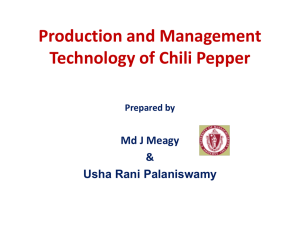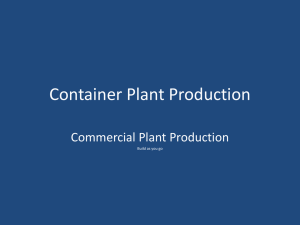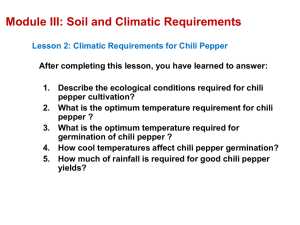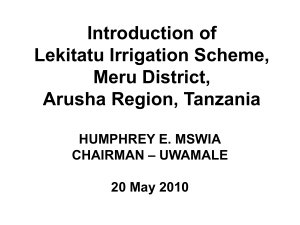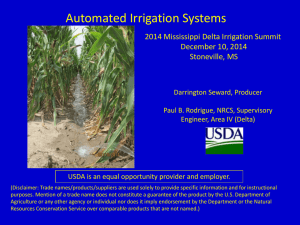Module X: Soil Moisture Relationships and Irrigation
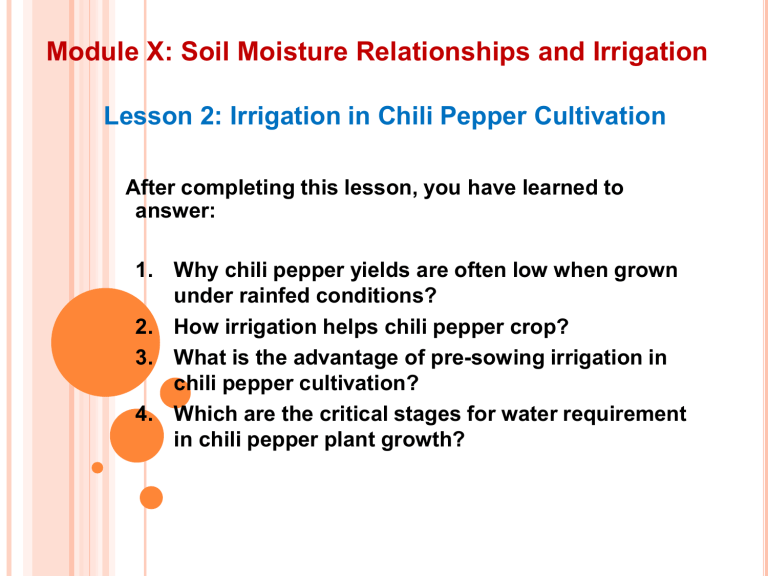
Module X: Soil Moisture Relationships and Irrigation
Lesson 2: Irrigation in Chili Pepper Cultivation
After completing this lesson, you have learned to answer:
1.
Why chili pepper yields are often low when grown under rainfed conditions?
2.
How irrigation helps chili pepper crop?
3.
What is the advantage of pre-sowing irrigation in chili pepper cultivation?
4.
Which are the critical stages for water requirement in chili pepper plant growth?
Module X: Soil Moisture Relationships and Irrigation
Lesson 2: Irrigation in Chili Pepper Cultivation
After completing this lesson, you have learned to answer:
4. What symptoms help you to decide the irrigation requirement for chili pepper crop?
5. List the irrigation schedule for a ratoon chili pepper crop?
6. What contingency plan you will follow in the event of drought during the chili pepper crop growth?
Module X: Soil Moisture Relationships and Irrigation
Lesson 2: Irrigation in Chili Pepper Cultivation
Chili pepper is mainly grown under irrigated situation. Only about 8% of chili pepper area is rainfed.
Chili pepper crop is exposed to drought conditions very often during its growth and consequently the yields are lower than the potential yield.
So, if the farmers want higher chili pepper yields even during the rainy season, the answer is irrigation if water is available.
Module X: Soil Moisture Relationships and Irrigation
Lesson 2: Irrigation in Chili Pepper Cultivation
How irrigation helps chili pepper crop?
•
Allows efficient use of inputs
•
Increases yield
•
Improves quality of grain
•
Improves reliability and reduces risk
•
Increases profitability
Module X: Soil Moisture Relationships and Irrigation
Lesson 2: Irrigation in Chili Pepper Cultivation
Adequate soil moisture at sowing assure uniform plant stand and contributes to early plant growth.
Pre-plant irrigation can supply this moisture when early rains do not fill the root zone prior to planting.
If the seedbed contains sufficient moisture for good germination and early plant growth but subsoil moisture is lacking, water may be supplied by irrigating the crop after emergence.
Module X: Soil Moisture Relationships and Irrigation
Lesson 2: Irrigation in Chili Pepper Cultivation
Allowing seed to remain in dry soil for several days may result in poor germination and seedling vigour.
So, irrigation prior to sowing is recommended if water is available.
Whether irrigating before or after planting, apply no more water than required to fill the effective root zone.
Encourage deep rooting by maintaining only moderate soil moisture levels during early vegetative growth.
Module X: Soil Moisture Relationships and Irrigation
Lesson 2: Irrigation in Chili Pepper Cultivation
Moderate plant moisture stress during early vegetative growth normally does not significantly limit grain yield.
However, adequate moisture must be available by the boot stage.
Irrigation at the flowering to fruits stages also has consistently maintained high yield potential.
Module X: Soil Moisture Relationships and Irrigation
Lesson 2: Irrigation in Chili Pepper Cultivation
Irrigation intervals and the amount of water to apply is determined by:
• rainfall
• soil's water-holding characteristics
• plant rooting depth and
• other climatic conditions like air temperature etc.
Module X: Soil Moisture Relationships and Irrigation
Lesson 2: Irrigation in Chili Pepper Cultivation
The visible signs for giving the irrigation to the crop or the moisture requirement of crop are:
• drooping and withering of leaves during morning period, leaves feel some what warm during noon instead of cool, and
• cracking of the soil surface of the field.
Plan irrigations to provide adequate soil moisture during these high water requirement periods.
Module X: Soil Moisture Relationships and Irrigation
Lesson 2: Irrigation in Chili Pepper Cultivation
Irrigation for a ratoon crop i.
Irrigate immediately after harvest the main crop.
i.
Irrigation should not be delayed for more than
24 hours after cutting.
iii. Irrigate on 3rd or 4th day after cutting.
iv. Subsequently irrigate once in 7-10 days.
v. Stop irrigation on 70-80 days after ratooning.
Module X: Soil Moisture Relationships and Irrigation
Lesson 2: Irrigation in Chili Pepper Cultivation
Drought Contingency Plan For Rainy Season Crop
1. Early onset of monsoon followed by a long gap:
Repeated intercultivation operations for some moisture conservation like hoeing, weeding and mulching are suggested.
Under severe moisture stress, reduce the plant population by 2/3 by thinning for judicious use of moisture.
Module X: Soil Moisture Relationships and Irrigation
Lesson 2: Irrigation in Chili Pepper Cultivation
Drought Contingency Plan For rainy season
2. Delayed onset of monsoon:
Normal recommendation can be followed. In case there is delay in monsoon by 2-3 week, short duration cultivars such as CSH 6 and CSH 14 can be preferred.
Module X: Soil Moisture Relationships and Irrigation
Lesson 2: Irrigation in Chili Pepper Cultivation
Summary: Light Soils
Crop Stage Irrigations After sowing
Germination or establishment
Regulate irrigation during vegetative phase
Flowering phase
(copious irrigation)
Maturity phase
(control irrigation)
Stop irrigation thereafter
1
2
3
1
2
1
2
1
2
1st day
4th day
15th day
28th day
40 th day
52nd day
64th day
75th day
88th day
Module X: Soil Moisture Relationships and Irrigation
Lesson 2: Irrigation in Chili Pepper Cultivation
Summary: Heavy Soils
Crop Stage Irrigations After sowing
Germination or establishment
Regulate irrigation during vegetative phase
Flowering phase
(copious irrigation)
Maturity phase
(control irrigation)
Stop irrigation thereafter
1
2
1
2
1
1
2
1st day
4th day
17th day
30th day
45 th day
60th day
90th day
Module X: Soil Moisture Relationships and Irrigation
Lesson 2: Irrigation in Chili Pepper Cultivation
With this, the Lesson 2 on irrigation in chili pepper cultivation, and also this Module 10 concludes.
If you would like to check your understanding about soil moisture and irrigation in chili pepper cultivation, please click on the “Exercise” button given above.
Next, Module 11 provides information about harvesting and storing of chili pepper .
Click “Modules” button and select Module 11
